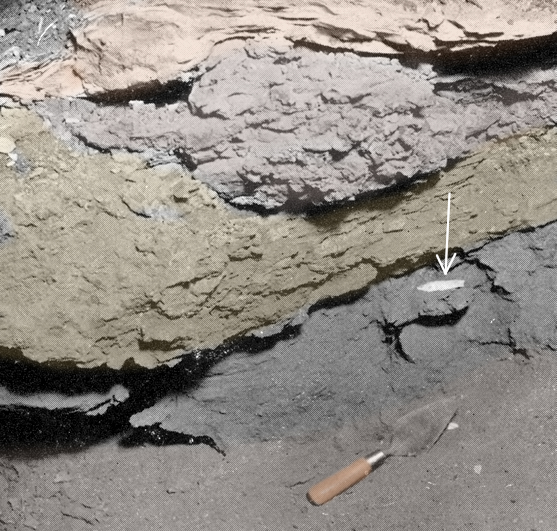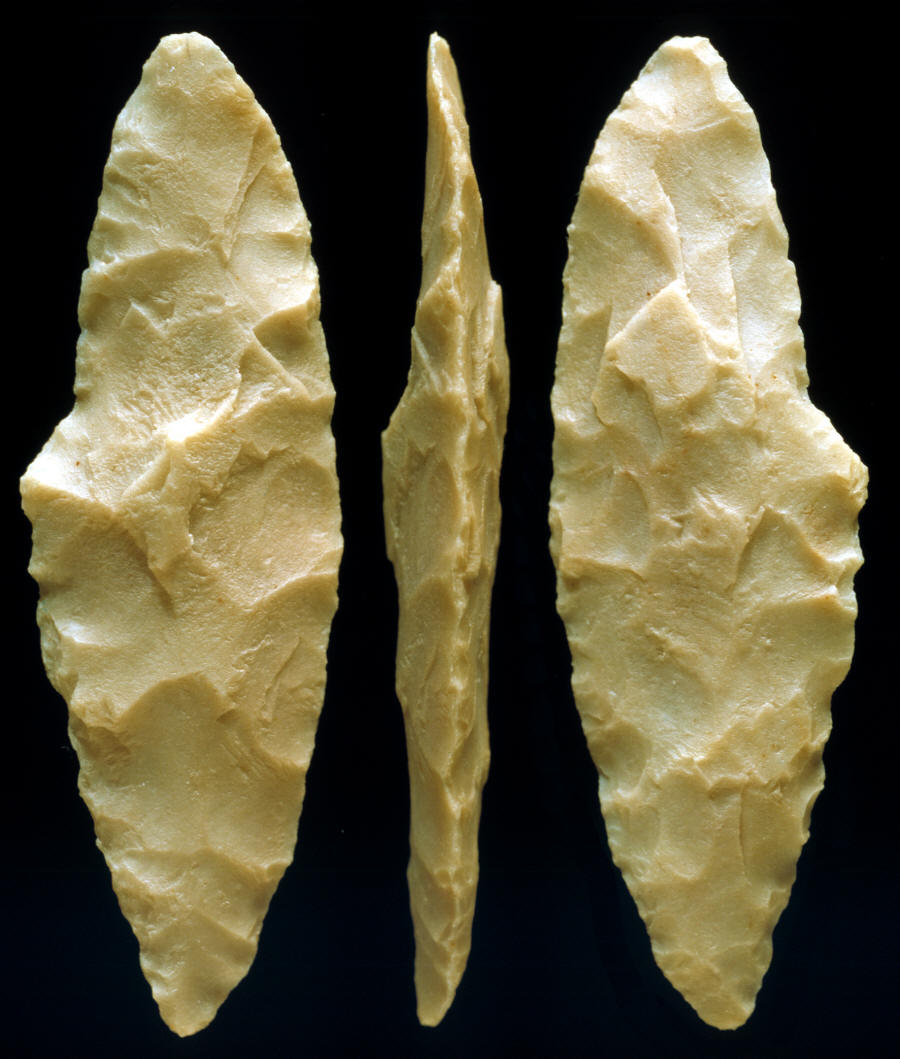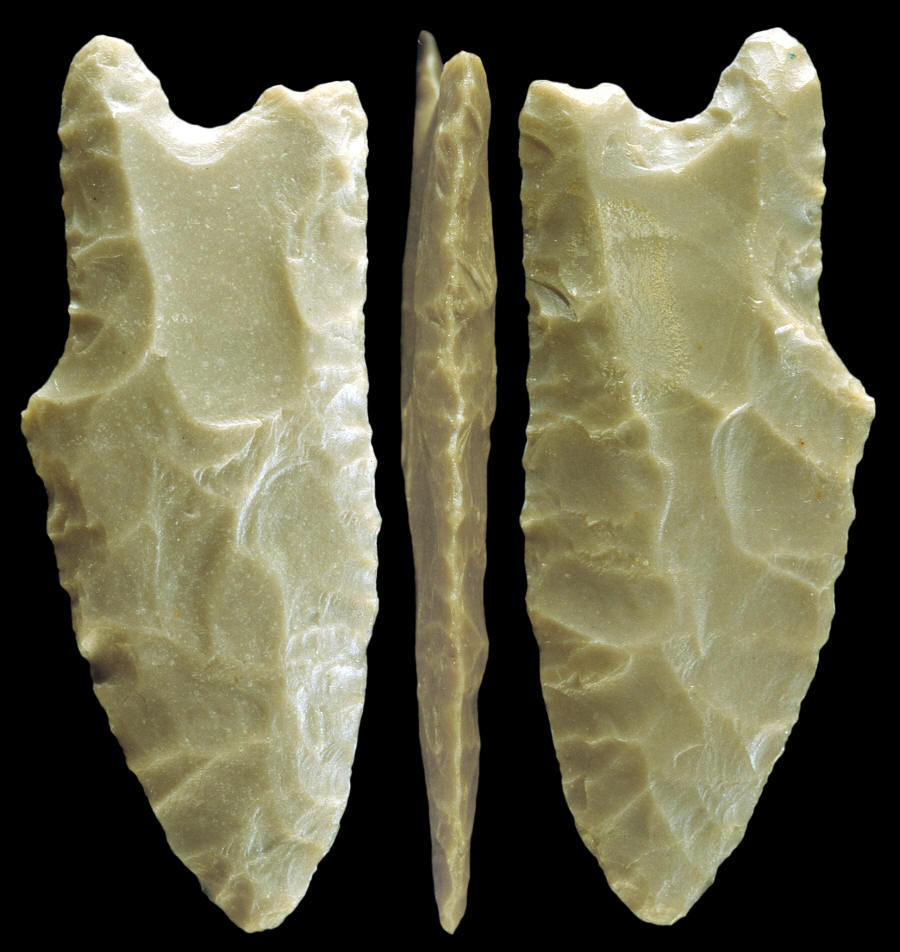Abstract
Sandia Cave generated much interest when in the 1940s
extinct Pleistocene megafauna were reported in association
with what appeared to be a pre-Folsom Paleoindian component.
By the 1950s a series of controversies regarding the stratigraphy
and dating began to push the site into obscurity. The human
occupation at the site has never been directly dated beyond
2250 ± 50 BP, and nonartifactual associated bone will not
provide reliable age estimates because of extensive bioturbation,
poor provenience, and the fact that the majority of fossils were
accumulated by carnivores and rodents, rather than humans. However,
a small number of mineralized fragments display human modification,
suggesting occasional human activity of some antiquity at the site.
One bone tool, one burned bone, and four bones bearing butchery marks
were subjected to direct Accelerator Mass Spectrometry (AMS) 14C dating.
Unfortunately, mineralized bones did not preserve sufficient collagen
to be dated. Two unmineralized specimens (the burned bone and the bone tool)
push the direct chronometric ages for the human occupation at Sandia Cave
back to 3447 ± 96 BP. An older Folsom occupation is suggested by associated
dates on breccia, but all lines of evidence taken together provide no
support for a pre-Folsom human occupation.
_________________________________________________________________________________________________________________
"...Although the site unquestionably contained Pleistocene
fauna, most of the large mammal fossils
were likely deposited while the site was used as a
carnivore den (Thompson et a1. 2008)..."
"...human occupation was evidenced by low levels of
human modification on the bone..."
"...In 1935, a mandible was excavated from
Sandia Cave under the direction of Wesley Bliss
(1940a, 1940b), who also worked with Hibben on
the original excavations. The mandible was recovered
by Chester Stock of the Los Angeles
County Museum in California from a hearth in the
back of the "vestibule" about 10 m from the
mouth of the cave. The hearth contained the first
example of a Sandia point along with what were
interpreted to be bola balls (Bliss 1940a)..."
"...The distal end of the mandible is dark grey to
black, rather than brown like the remainder of the
specimen (see Figure 3). This suggested it was either
burned or stained by wad, a mineralogical
family of brown to black hydrated manganese
oxides. This type of manganese mineralization
had been observed in the limonite ocher (Stratum
C) of Sandia Cave (Haynes and Agogino 1986).
In 2002, the specimen was subjected to qualitative
analysis by x-ray fluorescence at a University of
Arizona medical facility and found to have very
little Mn in either the brown or the black portions,
suggesting that the black was attributable to charring
and not Mn mineralization (see Table I)..."
"...The AMS technique for 14C dating allowed
the small sample of 2.9 mg of black carbon
to yield an age of 3,447 ± 96 BP (AA-49057).
Burned bone has been known to yield 14C ages
that are too young (Haynes 1967), so the age could
be considered a minimum value. However, there is
the possibility that the mandible was already fossilized
at the time it was burned in the hearth..."
"...three subgroups: (1) least altered and stained, (2) bones of inter-
mediate stage, and (3) most corroded and yellow ocher stained..."
"...The mandible of this report would
be classified as falling into group 3, most corroded
and stained. This raises the question of its
age at the time of charring..."
"...Because percussion flakes occur in the original Sandia Cave assemblage,
this confirms that at least occasionally humans made use of the site for
the processing and consumption of faunal remains..."
"...Figure 4. Photographs of the dated specimens showing human modification with close-ups in boxed area: (a) cut and percussion marks, specimen 3.69; (b) percussion mark, specimen 16.28; (c) cut marks, specimen 42.24; (d) percussion mark on flake, specimen 46.4; and (e) bone tool, specimen 45.1..."
"...Table 2. Results of AMS Dating for Human-Modified Specimens at Sandia Cave..."
"...Laboratory#/ Specimen#/ Specimen Type/ Surface Modification/ Mineralization..."
"...AA74240/ 16.28'(a)/ Long bone midshaft fragment/ Percussion mark/ Heavy..."
"...AA74241/ 3.69' (a)/ Long bone midshaft fragment/ Cut and percussion/ Heavy..."
"...AA74242/ 42.24 (a)/ Long bone midshaft fragment/ Cut marks/ Heavy..."
"...(a)Insufficient collagen could be extracted to recommend attempting to date the specimen..."
"...Because only unfossilized specimens could produce 14C
ages, there are no concerns about ancient carbon
from the limestone environment becoming incorporated
into the bone and making the ages appear
too old. Despite the inability of the fossilized
bones to produce an age in this particular case, it
should be stressed that dating of bone that specifically
bears butchery marks is a method that
should adopted elsewhere, as it minimizes the
potential effects of bioturbation and truly targets
the dating of human-faunal interactions when the
bone was in a nutritive state..."
"...Clear signs of human modification occur on lightly
to heavily mineralized bone fragments at Sandia
Cave, suggesting human occupation of some antiquity.
Because of extensive bioturbation at the
site, we employed AMS 14C dating on these culturally
modifIed specimens to determine a more
precise estimate of the age of human occupation of
the site. We suggest that this approach, which requires
an intimate pairing of taphonomy and radiochronology,
is one that should be adopted for sites where extensive bioturbation has introduced
question to the association between cultural and
faunal remains. Although in this case adequate
collagen could not be extracted from specimens
exhibiting butchery damage, a burned specimen
from a hearth feature and a bone tool could be
dated. Our results indicate that although Sandia
Cave is a genuine Pleistocene paleontological locality
and likely also contains genuine Folsom
material, any human occupation at the site cannot
be directly radiometrically dated beyond 3,447 ±
96 years BP..."
RADIOCARBON DATING THE HUMAN OCCUPATION
AT SANDIA CAVE, NEW MEXICO
Jessica C. Thompson and C. Vance Haynes, Jr.
American Antiquity 77(2), 2012. pp. 303-314
http://saa.metapress.com/content/y24hhnh77wv64467/
Sandia Point in situ at Sandia Cave
Sandia Point from Sandia Cave
http://www.flickr.com/photos/94515086@N00/2329397738/
A Sandia Point, found by Hibben in Sandia Cave. Note the single shouldered design, a shape unique in the Americas and reminiscent of European paleo-cultures.
http://forgottenabq.blogspot.com/2008/0 ... art-1.html
TYPE I SANDIA POINT CAST
TYPE II SANDIA POINT CAST
http://lithiccastinglab.com/gallery-pages/2010junesandiapointspage1.htm
Charlie Hatchett
www.pre-clovis.com
www.forum.pre-clovis.com
www.blog.pre-clovis.com
Sandia Cave generated much interest when in the 1940s
extinct Pleistocene megafauna were reported in association
with what appeared to be a pre-Folsom Paleoindian component.
By the 1950s a series of controversies regarding the stratigraphy
and dating began to push the site into obscurity. The human
occupation at the site has never been directly dated beyond
2250 ± 50 BP, and nonartifactual associated bone will not
provide reliable age estimates because of extensive bioturbation,
poor provenience, and the fact that the majority of fossils were
accumulated by carnivores and rodents, rather than humans. However,
a small number of mineralized fragments display human modification,
suggesting occasional human activity of some antiquity at the site.
One bone tool, one burned bone, and four bones bearing butchery marks
were subjected to direct Accelerator Mass Spectrometry (AMS) 14C dating.
Unfortunately, mineralized bones did not preserve sufficient collagen
to be dated. Two unmineralized specimens (the burned bone and the bone tool)
push the direct chronometric ages for the human occupation at Sandia Cave
back to 3447 ± 96 BP. An older Folsom occupation is suggested by associated
dates on breccia, but all lines of evidence taken together provide no
support for a pre-Folsom human occupation.
_________________________________________________________________________________________________________________
"...Although the site unquestionably contained Pleistocene
fauna, most of the large mammal fossils
were likely deposited while the site was used as a
carnivore den (Thompson et a1. 2008)..."
"...human occupation was evidenced by low levels of
human modification on the bone..."
"...In 1935, a mandible was excavated from
Sandia Cave under the direction of Wesley Bliss
(1940a, 1940b), who also worked with Hibben on
the original excavations. The mandible was recovered
by Chester Stock of the Los Angeles
County Museum in California from a hearth in the
back of the "vestibule" about 10 m from the
mouth of the cave. The hearth contained the first
example of a Sandia point along with what were
interpreted to be bola balls (Bliss 1940a)..."
"...The distal end of the mandible is dark grey to
black, rather than brown like the remainder of the
specimen (see Figure 3). This suggested it was either
burned or stained by wad, a mineralogical
family of brown to black hydrated manganese
oxides. This type of manganese mineralization
had been observed in the limonite ocher (Stratum
C) of Sandia Cave (Haynes and Agogino 1986).
In 2002, the specimen was subjected to qualitative
analysis by x-ray fluorescence at a University of
Arizona medical facility and found to have very
little Mn in either the brown or the black portions,
suggesting that the black was attributable to charring
and not Mn mineralization (see Table I)..."
"...The AMS technique for 14C dating allowed
the small sample of 2.9 mg of black carbon
to yield an age of 3,447 ± 96 BP (AA-49057).
Burned bone has been known to yield 14C ages
that are too young (Haynes 1967), so the age could
be considered a minimum value. However, there is
the possibility that the mandible was already fossilized
at the time it was burned in the hearth..."
"...three subgroups: (1) least altered and stained, (2) bones of inter-
mediate stage, and (3) most corroded and yellow ocher stained..."
"...The mandible of this report would
be classified as falling into group 3, most corroded
and stained. This raises the question of its
age at the time of charring..."
"...Because percussion flakes occur in the original Sandia Cave assemblage,
this confirms that at least occasionally humans made use of the site for
the processing and consumption of faunal remains..."
"...Figure 4. Photographs of the dated specimens showing human modification with close-ups in boxed area: (a) cut and percussion marks, specimen 3.69; (b) percussion mark, specimen 16.28; (c) cut marks, specimen 42.24; (d) percussion mark on flake, specimen 46.4; and (e) bone tool, specimen 45.1..."
"...Table 2. Results of AMS Dating for Human-Modified Specimens at Sandia Cave..."
"...Laboratory#/ Specimen#/ Specimen Type/ Surface Modification/ Mineralization..."
"...AA74240/ 16.28'(a)/ Long bone midshaft fragment/ Percussion mark/ Heavy..."
"...AA74241/ 3.69' (a)/ Long bone midshaft fragment/ Cut and percussion/ Heavy..."
"...AA74242/ 42.24 (a)/ Long bone midshaft fragment/ Cut marks/ Heavy..."
"...(a)Insufficient collagen could be extracted to recommend attempting to date the specimen..."
"...Because only unfossilized specimens could produce 14C
ages, there are no concerns about ancient carbon
from the limestone environment becoming incorporated
into the bone and making the ages appear
too old. Despite the inability of the fossilized
bones to produce an age in this particular case, it
should be stressed that dating of bone that specifically
bears butchery marks is a method that
should adopted elsewhere, as it minimizes the
potential effects of bioturbation and truly targets
the dating of human-faunal interactions when the
bone was in a nutritive state..."
"...Clear signs of human modification occur on lightly
to heavily mineralized bone fragments at Sandia
Cave, suggesting human occupation of some antiquity.
Because of extensive bioturbation at the
site, we employed AMS 14C dating on these culturally
modifIed specimens to determine a more
precise estimate of the age of human occupation of
the site. We suggest that this approach, which requires
an intimate pairing of taphonomy and radiochronology,
is one that should be adopted for sites where extensive bioturbation has introduced
question to the association between cultural and
faunal remains. Although in this case adequate
collagen could not be extracted from specimens
exhibiting butchery damage, a burned specimen
from a hearth feature and a bone tool could be
dated. Our results indicate that although Sandia
Cave is a genuine Pleistocene paleontological locality
and likely also contains genuine Folsom
material, any human occupation at the site cannot
be directly radiometrically dated beyond 3,447 ±
96 years BP..."
RADIOCARBON DATING THE HUMAN OCCUPATION
AT SANDIA CAVE, NEW MEXICO
Jessica C. Thompson and C. Vance Haynes, Jr.
American Antiquity 77(2), 2012. pp. 303-314
http://saa.metapress.com/content/y24hhnh77wv64467/
Sandia Point in situ at Sandia Cave
Sandia Point from Sandia Cave
http://www.flickr.com/photos/94515086@N00/2329397738/
A Sandia Point, found by Hibben in Sandia Cave. Note the single shouldered design, a shape unique in the Americas and reminiscent of European paleo-cultures.
http://forgottenabq.blogspot.com/2008/0 ... art-1.html
TYPE I SANDIA POINT CAST
TYPE II SANDIA POINT CAST
http://lithiccastinglab.com/gallery-pages/2010junesandiapointspage1.htm
Charlie Hatchett
www.pre-clovis.com
www.forum.pre-clovis.com
www.blog.pre-clovis.com





